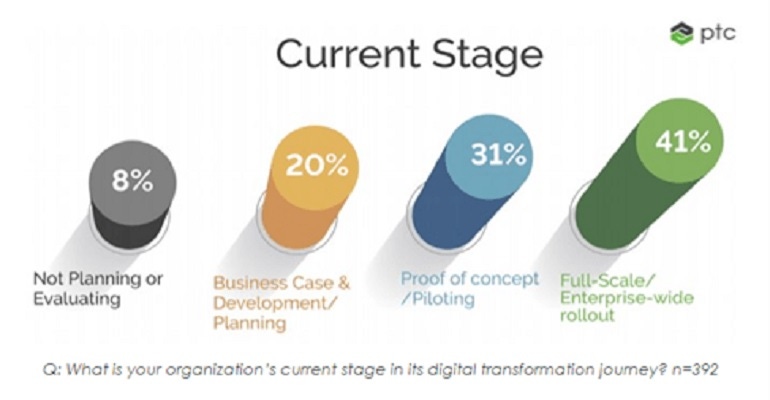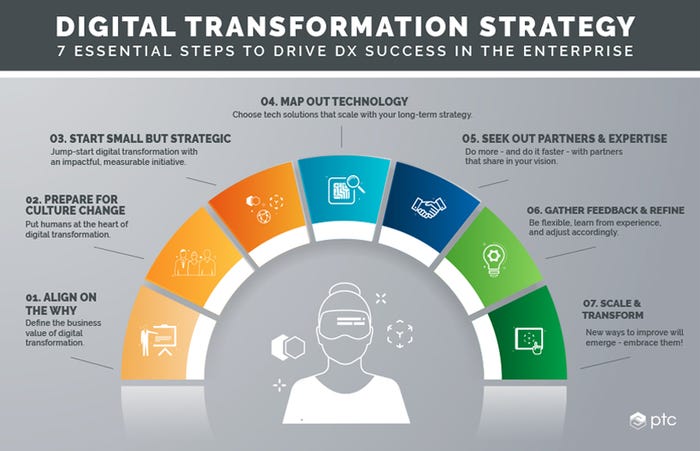Has the Digital Transformation Arrived for Manufacturing?
To see how transformation was affecting manufacturers, PTC surveyed leaders at more than 360 manufacturers in The State of Industrial Digital Transformation report.
November 2, 2021

One constant through the turbulence of the pandemic was the increasing use of digital technologies. IDC estimates that global spending on digital transformation (DX) technologies and services hit an impressive $1.3 trillion in 2020.
To see how this transformation was affecting manufacturers, PTC surveyed leaders at more than 360 manufacturers in The State of Industrial Digital Transformation. Respondents indicated that 92% of them are already on their digital transformation journey. This is surprising when you consider the market uncertainty of the pandemic. On the other hand, the pandemic revealed the need for digital systems.
PTC’s survey results highlight that even with economic uncertainty, COVID-19 hasn’t delayed digital projects and, in many cases, has pushed them further along. More than 40% of companies signaled the importance of continuing with their original program timeline and 25% cited newly introduced or accelerated DX projects.
Digital Systems Helped During the Pandemic
More than 90% of manufacturing leaders claim that digital investments made before the pandemic allowed them to overcome the hurdles posed by COVID-19. “The survey results expose critical nuances to digital transformation strategies based on the maturity of their programs. Those programs fall into three distinct stages: planning, piloting, and rollout,” Craig Melrose, EVP of digital transformation solutions at PTC, told Design News.
Melrose noted that he wasn’t surprised that COVID-19 didn’t delay the digital projects launched by manufacturers. “With the pandemic, there was even more need for remote access. We were already leveraging remote access and now we have to expand that,” said Melrose. “We have to think of remote work differently. We need to do business differently, and we need technology to do it.”
He also noted that the disruption brought about by COVID-19 opened opportunities for change. “Don’t let a good crisis go to waste,” said Melrose. “We need to adjust our existing plans to grow upon. And because of all the change, there is less resistance than ever to change management.”

A Changed World Calls for Digital Systems
The survey revealed another surprising trend. A quarter of the respondents said the pandemic either prompted new digital plans or accelerated existing digital efforts. “COVID-19 accelerated these projects,” said Melrose. “There was pressure on the system already, and COVID-19 accelerated that pressure. We were forced to do business in a new way.”
Melrose explained that companies that initially focused on digital initiatives to improve the efficiency of their current operations found they were suddenly in a better position to capitalize on growth and experience-focused goals. “You have a better starting point when you’re in a better cost structure,” said Melrose. “There are tangible and intangible benefits of digital transformation. It can become a secret sauce or a competitive advantage. Every company has a different set of reasons for why they're in digital transformation, whether it’s cost savings or agility. Whatever that is, it’s in a better position now.”
With 92% of industrial companies embarked on a digital journey, there are compelling driving factors, whether it involves optimizing operations or getting ahead of the competition. “What we’re seeing is like an innovator's curve, and we’re on the early curve,” said Melrose. “Most of the reasons are positive – reducing cost or gaining an advantage. I wouldn’t doubt some people are worried about falling behind, but it’s mostly they’re seeking advantages. Companies reach plateaus, and the digital transformation is the new tool to break the plateau and move to the next horizon. So people are feeling comfortable starting their transformation.”
The Digital Transformation Future
Melrose noted that the future for manufacturers depends on where they are on their digital journey. That position determines the priorities and challenges. “For a company that is at the beginning of their digital transformation, they may take steps toward the low hanging fruit. For a company that has already captured their low-hanging fruit, they’re looking at how to reduce the cost of a product, how to manage service levels, or how to create markets. Depending on whether you’re in the early, middle, or advanced stages, you have different priorities and needs.”
With security breaches nearly ubiquitous across industries, the idea of adding new digital systems must certainly prompt concerns. These concerns need to be addressed during the digital transformation. “Companies don’t share their views of security easily,” said Melrose. “In general, security has always been something to think about. It is critical whether it’s internal or external.”
Melrose noted that security will always be part of the planning and execution of digital systems. “Security will forever be an issue,” said Melrose.” As people are driving their digital transformation, security is embedded in their process. Still, these are exciting times for PTC and our customers. Digital transformation is more real than it’s ever been and it brings a game-changing outcome.”
About the Author(s)
You May Also Like





